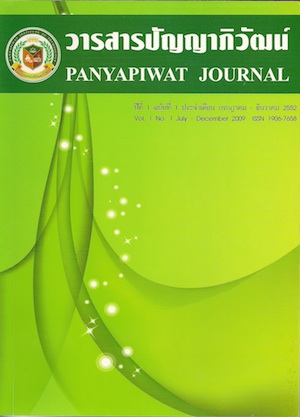Order Allocation Under Uncertainty Considering Suppliers' Perfomance: A Case Study of Laminate Manufacturer
Main Article Content
บทคัดย่อ
บทคัดย่อ
ในการบริหารจัดการห่วงโซ่อุปทานนั้นมีปัญหาในการตัดสินใจที่สำคัญประการหนึ่ง คือการจัดสรรคำสั่งซื้อให้กับผู้ป้อนวัสดุภายใต้ความไม่แน่นอนต่างๆ ปัญหานี้ต้องการข้อมูลจำนวนมากในการหาคำตอบที่ดีที่สุดสำหรับการตัดสินใจต่อปัญหาที่มีอยู่ ณ ขณะใดขณะหนึ่ง ดังนั้นจึงถือเป็นปัญหาที่ซับซ้อนโดยตัวของปัญหาเองงานวิจัยนี้จะมุ่งเน้นไปที่การหาวิธีการในการจัดสรรคำสั่งซื้อไปยังกลุ่มผู้ป้อนวัสดุที่มีอยู่จำนวนหนึ่ง ความไม่แน่นอนที่เกิดขึ้นในงานวิจัยนี้ประกอบด้วยความไม่แน่นอนของราคาวัสดุ ความผิดพลาดของการพยากรณ์ ความไม่สม่ำเสมอของคุณภาพวัสดุ และความไม่แน่นอนของการจัดส่ง ทีมผู้วิจัยได้ทำการศึกษากรณีศึกษาของบริษัทที่ทำการผลิตแผ่นลามิเนตซึ่งผู้ที่ทำการตัดสินใจจะต้องทำการจัดสรรปริมาณคำสั่งซื้อไปยังผู้ป้อนวัสดุแต่ละเจ้าซึ่งมีลักษณะและมีความไม่แน่นอนที่แตกต่าง วัตถุประสงค์ของการศึกษานี้คือการหารูปแบบการกระจายคำสั่งซื้อโดยมีต้นทุนรวมต่ำที่สุด ทางทีมผู้วิจัยได้ทำการพัฒนาตัวต้นแบบทางคณิตศาสตร์ของปัญหาขึ้น และใช้วิธีการทางพันธุวิศวกรรม (Genetic Algorithm) ในการแก้ปัญหาดังกล่าว ซึ่งวิธีการที่ได้พัฒนาขึ้นนี้ถูกทดสอบโดยการใช้ข้อมูลจริงที่ได้จากบริษัทรวมกับข้อมูลบางส่วนที่ได้จากการพยากรณ์และนำไปเปรียบเทียบกับค่าที่ดีที่สุดที่ได้จากการใช้โปรแกรม LINGO ซึ่งจากผลการเปรียบเทียบพบว่าวิธีการที่ได้พัฒนาขึ้นนั้นให้ค่าผลลัพธ์ที่ดีและยอมรับได้ภายใต้ความไม่แน่นอนต่างๆ ที่เกิดขึ้น
คำสำคัญ : การบริหารห่วงโซ่อุปทาน, การจัดสรรคำสั่งซื้อ, ความไม่แน่นอน
Abstract
One of the most important decision-makings in a supply chain is how to allocate the order to suppliers under uncertainty. This type of problem requires much information in order to find the best decision for the problem at hand; therefore, it is very complicate by nature. This research focuses on how to allocate the order to a set of selected suppliers. The uncertainties considered in this research consist of fluctuation of raw material price, inaccuracy in forecasting, product quality, and ratio of on-time delivery of suppliers. We have studied a case study of a laminate manufacturer in Thailand, in which, the decision maker has to decide how to order the raw material from suppliers while each supplier has different characteristics or different uncertainty. The objective of this study is to assign the order allocation pattern, which minimize the total corresponding costs. We have developed the mathematical model and have applied the Genetic Algorithm to develop the program for optimizing the total cost. Then, algorithm has been tested using the data retrieved from the company and the data from the forecasting. Moreover, we have solved the tested case by the LINGO software in order to verify the efficiency of the proposed algorithm. The results show that our algorithm works very well under uncertainty and can suggest the best decision under each category of uncertainty.
Keywords : Supply Chain Management, Order allocation, Uncertainty
Article Details
“ข้าพเจ้าและผู้เขียนร่วม (ถ้ามี) ขอรับรองว่า บทความที่เสนอมานี้ยังไม่เคยได้รับการตีพิมพ์และไม่ได้อยู่ระหว่างกระบวนการพิจารณาลงตีพิมพ์ในวารสารหรือแหล่งเผยแพร่อื่นใด ข้าพเจ้าและผู้เขียนร่วมยอมรับหลักเกณฑ์การพิจารณาต้นฉบับ ทั้งยินยอมให้กองบรรณาธิการมีสิทธิ์พิจารณาและตรวจแก้ต้นฉบับได้ตามที่เห็นสมควร พร้อมนี้ขอมอบลิขสิทธิ์บทความที่ได้รับการตีพิมพ์ให้แก่สถาบันการจัดการปัญญาภิวัฒน์หากมีการฟ้องร้องเรื่องการละเมิดลิขสิทธิ์เกี่ยวกับภาพ กราฟ ข้อความส่วนใดส่วนหนึ่งและ/หรือข้อคิดเห็นที่ปรากฏในบทความข้าพเจ้าและผู้เขียนร่วมยินยอมรับผิดชอบแต่เพียงฝ่ายเดียว”
เอกสารอ้างอิง
Anshuman G., Costas D.M. (2003), Managingdemand uncertainty in supply chain planning.Computers & Chemical Engineering, 27(8-9), 1219-1227.
Brian F., Sean de B., Donna M. (2004),Environmental uncertainty, supply chainrelationship quality and performance.Journal of Purchasing and Supply Management, 10(4-5), 179-190.
Cheng-Liang C., Wen-Cheng L. (2004), Multi-objective optimization of multi-echelonsupply chain networks with uncertainproduct demands and prices. Computers &Chemical Engineering, 28(6-7), 1131-1144.
Choy K.L., Lee W.B., Victor L., (2002) Anintelligent supplier management tool forbenchmarking suppliers in outsourcemanufacturing. Expert Systems withApplications, 22(3), 213-224.
Christopher D.I., David F.L., Benkatesh N.,Madhav C.R. (1999) Supplier selection,monitoring practices, and firm performance.Journal of Accounting and Public Policy,18(3), 253-281.
Ghodsypour S.H., O'Brien C., (1998) A decisionsupport system for supplier selection usingan integrated analytic hierarchy process andlinear programming. International Journalof Production Economics, 56-57, 199-212.
Jukka K, Kalevi K., Antti L., Markku T., (2002)An analytic approach to production capacityallocation and supply chain design.International Journal of ProductionEconomics, 78(2), 187-195.
June Y.J., Gary B., Joseph F.P., Gintaras V.R.,(2004) David E. A simulation basedoptimization approach to supply chainmanagement under demand uncertainty.Computers & Chemical Engineering,28(10), 2087-2106.
Kirstin Z., (2002) Supply chain coordination withuncertain just-in-time delivery. InternationalJournal of Production Economics, 77(1),1-15.
Luitzen de B., Leo van der W., Jan T., (1998)Outranking methods in support of supplierselection. European Journal of Purchas-ing & Supply management, 4(2-3), 109-118.
Madeleine E.P., (1998) An analysis of thesupplier selection process. Omega, 26(6),673-688.
Ram G., John E.T., (1999) Yuanming G. Dualsourced supply chains: the discount supplieroption. Transportation Research, 35(1),11-23.
Ruengsak K., Nguyen V.H., (2005) Orderallocation in a multiple-supplier environment.International Journal of Production Economics, 93-94, 231-238.
Stefan M., (2003) Multiple-supplier inventorymodels in supply chain management: Areview. International Journal of ProductionEconomics, 81-82, 265-279.
Thomas Y.C., Janet L.H., (1996) An explorationof supplier selection practices across thesupply chain. Journal of OperationsManagement, 14(4), 333-343.
Toshiya K., (2003) Multi-agent based supplychain modeling with dynamic environment.International Journal of ProductionEconomics, 85(2), 263-269.
Wen-Chyuan C., Robert A.R., (2004) Integrat-ing purchasing and routing in a propane gassupply chain. European Journal ofOperational Research, 154(3), 710-729.


